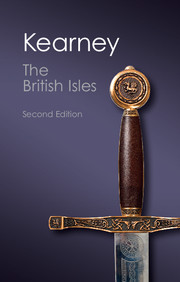Book contents
- Frontmatter
- Contents
- List of illustrations
- List of maps
- Preface to the first edition
- Preface to the second edition
- Map: the British Isles
- Introduction
- 1 The Celtic societies of the British Isles
- 2 The impact of Rome on the British Isles
- 3 The post-Roman centuries
- 4 The Vikings and the fall of the Old Order
- 5 The Norman and post-Norman ascendancy
- 6 The decline of the post-Norman empire
- 7 The making of an English empire
- 8 The remaking of an empire
- 9 The Britannic melting pot
- 10 The rise of ethnic politics
- 11 Between the wars
- 12 Withdrawal from empire
- 13 Post-imperial Britain: post-nationalist Ireland
- Afterword
- Selected reading list
- Index
12 - Withdrawal from empire
Published online by Cambridge University Press: 05 June 2014
- Frontmatter
- Contents
- List of illustrations
- List of maps
- Preface to the first edition
- Preface to the second edition
- Map: the British Isles
- Introduction
- 1 The Celtic societies of the British Isles
- 2 The impact of Rome on the British Isles
- 3 The post-Roman centuries
- 4 The Vikings and the fall of the Old Order
- 5 The Norman and post-Norman ascendancy
- 6 The decline of the post-Norman empire
- 7 The making of an English empire
- 8 The remaking of an empire
- 9 The Britannic melting pot
- 10 The rise of ethnic politics
- 11 Between the wars
- 12 Withdrawal from empire
- 13 Post-imperial Britain: post-nationalist Ireland
- Afterword
- Selected reading list
- Index
Summary
Winston Churchill once declared that he had not become the King's chief minister to preside over the dissolution of the British empire. In fact, however, the process of decolonisation which had begun before 1939 with the Statute of Westminster (1931), and perhaps even earlier with the Anglo-Irish Treaty of 1921, gathered momentum after 1945. The granting of independence to India, Pakistan, Ceylon and Burma in the late 1940s was accompanied by withdrawal from Palestine in 1948 and in 1954 from the Suez Canal Zone. An attempt to restore British influence in the Middle East with the Suez expedition of 1956 broke down in the face of American opposition.
During the 1960s, withdrawal from empire continued apace under Harold Macmillan and his colonial secretary Iain MacLeod. It was accompanied by a policy of drawing closer to the European Economic Community. Macmillan made the first application to enter Europe in 1962 but it was not until 1973 that Britain, together with the Republic of Ireland, was finally admitted to membership. Looked at in retrospect, this apparently inexorable process of moving from overseas empire to European community would seem to be the most significant trend of post-war Britain.
Within Britain the long-term impact of commitment to Europe was to intensify the drift to the south-east. The economic decline of the north and west which had been halted during the Second World War was resumed. As they had been during the 1920s and 1930s, rates of unemployment were much higher in ‘Outer Britain’.
Information
- Type
- Chapter
- Information
- The British IslesA History of Four Nations, pp. 294 - 303Publisher: Cambridge University PressPrint publication year: 2012
